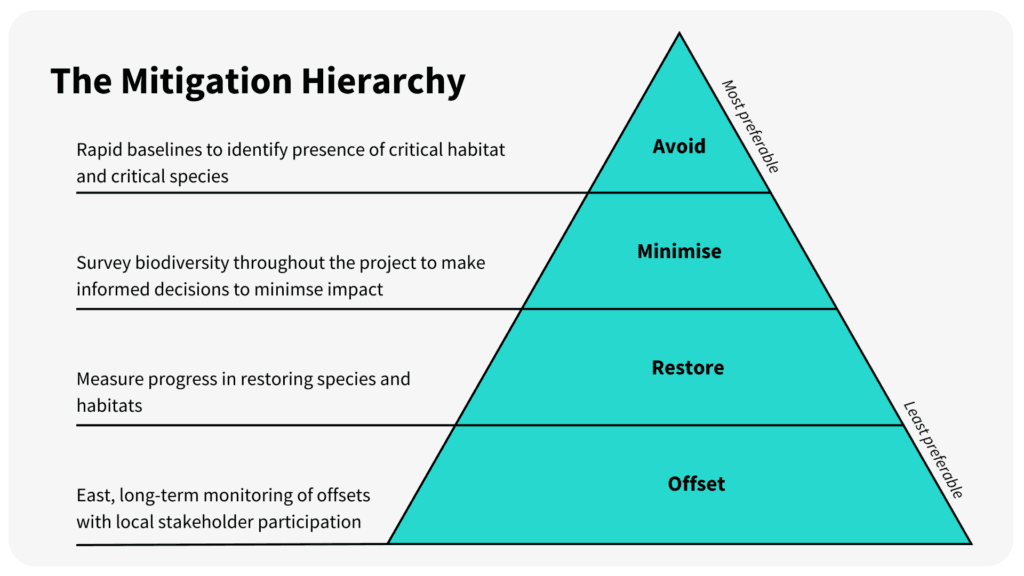Put Nature First With The Mitigation Hierarchy

For the leaders responsible for sustainability and environmental impact within their organisations, it’s vital to have an understanding of how the Mitigation Hierarchy can be a powerful tool in your biodiversity monitoring, eDNA analysis and management efforts. This hierarchy offers a framework that can genuinely make a difference in how your business interacts with the natural world.
What is the Mitigation Hierarchy?
More than just a step-by-step process, the Mitigation Hierarchy offers a way of thinking about and addressing environmental impact that puts the most effective actions first. The hierarchy starts with Avoidance, moves to Minimisation, on to Restoration, and finally, as a last resort, Offsetting.
We don’t run ads or share your data. If you value independent content and real privacy, support us by sharing.

Avoidance
Think of this as the “do no harm” stage. Before you break ground on a new project or expand operations, the goal is to steer clear of areas where your activities could cause significant harm to biodiversity. This might mean rerouting a project or changing your methods entirely. It’s proactive, not reactive, and the best way to ensure minimal impact to the environment.
Minimization
If some impact is unavoidable, the next best thing is to minimise it. This could involve tweaking your operations, such as timing construction to avoid disrupting local wildlife during critical periods like mating seasons, or using methods that reduce environmental disturbance.
Restoration
Sometimes, despite your best efforts, harm occurs. In these cases, you should focus on restoring the environment to its original state. This involves more than just planting a few trees and moving on to the next project, it’s about genuinely rehabilitating ecosystems and ensuring they can thrive again.
Offsetting
If all else fails, offsetting allows you to compensate for your impacts by supporting conservation efforts elsewhere. This could mean creating or protecting habitats that are ecologically similar to the ones affected by your operations. It’s not ideal, but it’s better than leaving the damage unaddressed.
Why Should You Care?
The Mitigation Hierarchy isn’t just a theoretical framework. It’s practical, actionable, and essential for modern businesses.
Why Should You Care?
The Mitigation Hierarchy isn’t just a theoretical framework. It’s practical, actionable, and essential for modern businesses.
- Regulatory Compliance: Many environmental laws and international guidelines require that businesses follow the Mitigation Hierarchy. While you will avoid fines by staying compliant, it should really mean more than that. Your efforts to demonstrate, in a genuine fashion, that your company takes its environmental responsibilities seriously.
- Risk Management: Applying the hierarchy helps you identify and mitigate risks early in the project planning stages. This proactive approach can save your company from costly delays, legal battles, and the kind of negative publicity that can tarnish your brand.
- Sustainability Leadership: Using the Mitigation Hierarchy positions your company as a leader in sustainability. It shows that you’re committed to reducing your environmental footprint and that you’re taking meaningful steps to protect biodiversity.
- Real Conservation Impact: At its heart, the Mitigation Hierarchy is about doing what’s best for the planet. By avoiding, minimising, and restoring environmental impacts, your company can play a significant role in conserving biodiversity. Aside from being good for the environment, it’s also great for the communities and economies that depend on healthy ecosystems.
How to Make it Work for You
Start early! The earlier you integrate the Mitigation Hierarchy into your project planning, the better. Conduct thorough environmental assessments at the outset to identify sensitive areas and plan your activities accordingly.
The Mitigation Hierarchy shouldn’t just be the responsibility of your environmental team, and you should seek to collaborate across departments. It should be a company-wide priority. Make sure that all relevant departments, like design, engineering, and operations, are on board.
Biodiversity monitoring isn’t a one-and-done task, so you should monitor continuously. It requires ongoing attention, keeping an eye on the effectiveness of your mitigation measures and being ready to adapt your strategies as needed.
Don’t operate in a vacuum, and make sure to engage with stakeholders – local communities, conservation experts, and regulators can help you ensure that your mitigation efforts are robust, transparent, and effective.
Your organisation’s biodiversity strategies should be far more than simple box-ticking exercises. This is an opportunity for your brand to be seen as being a responsible steward of the environment. By embracing this approach, you’ll not only protect the planet’s precious ecosystems but also strengthen your company’s reputation as a leader in sustainability. There are plenty of resources available to help you get started on saving the environment – and the planet.